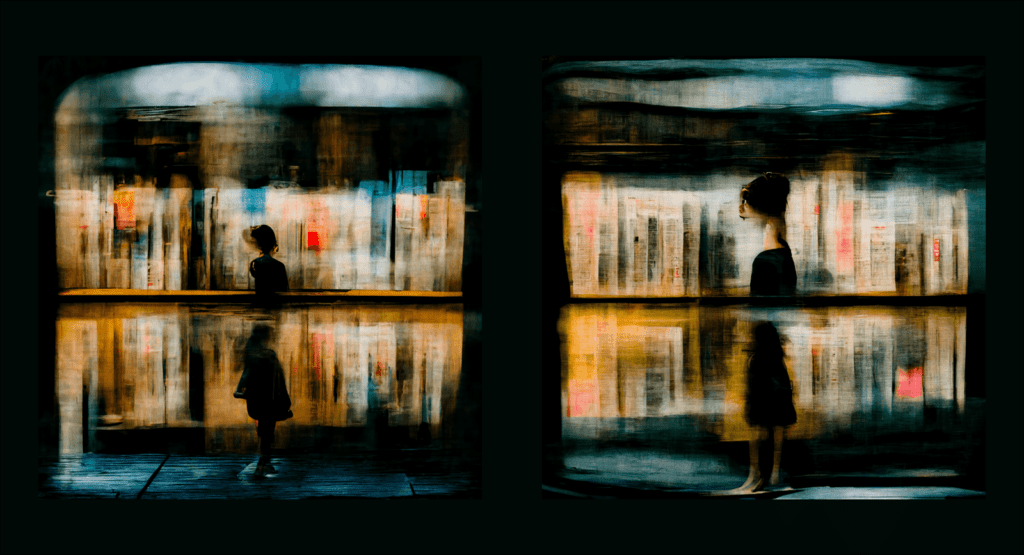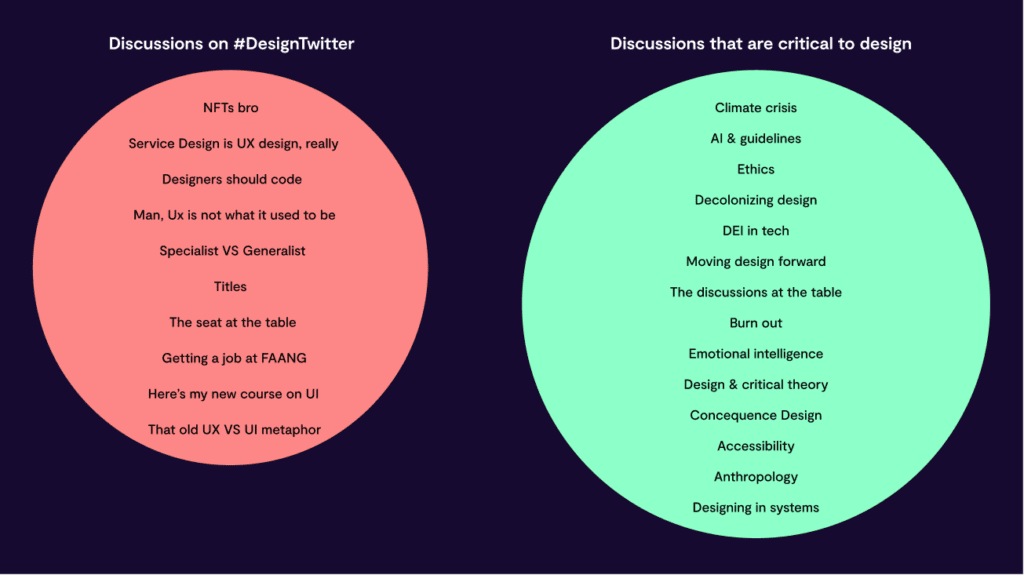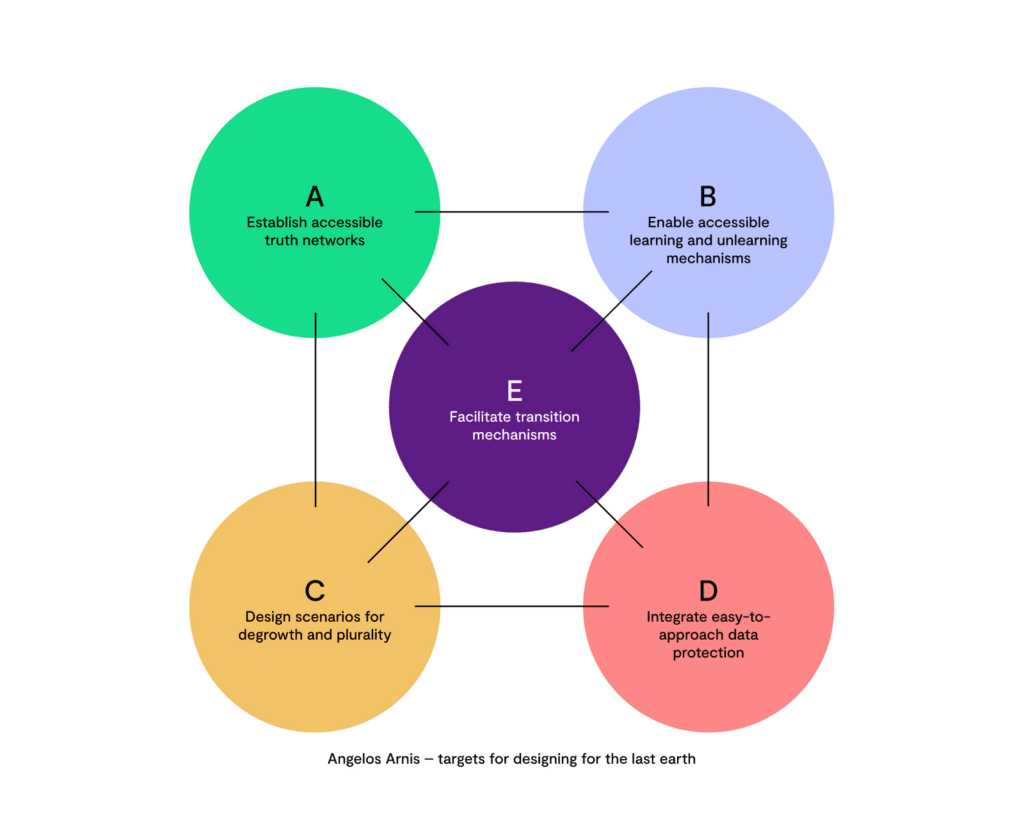
“I’m very concerned that our society is much more concerned with information than wonder, in noise rather than silence. How do we encourage reflection? … Oh my, this is a noisy world.”
– Mister Rogers
Design can be found everywhere. Design decisions are made with or without the involvement of professional designers. When I was fixing a bicycle, I made such decisions about the tools to be used, the parts and how they fit together, and the branding of everything. When I took my daughter to the playground, I was impressed by everything from the safety of the swing to the simple “boulder climbing set” for kids. Or when I queued at a restaurant for lunch, everything from the queuing system to how to pay with a lunch benefit to the utensils used to consume said food was designed.
It’s not that I’m blinded by the myth of design as the all-encompassing profession that leads to all important things in life… I am just wired to look at things through the design lens. There’s nothing wrong with that. Everyone sees reality through their own lenses, and their profession plays a significant role in this.
Meanwhile, the design field (digital or otherwise) has struggled for decades to achieve an invisible, and dare I say, imaginary seat at the table. In our efforts to get business to take us seriously, we have distorted the true value of design, which is what makes it unique in the first place. The true value of design, however, was never to find a single solution to a problem. But to understand, and explore.
There is a schism here. We are currently working in businesses that are wired to grow solely for profit, with old thinking that has harmed the very core of our reality through climate change, war, and, in more cases than we care to admit, the complete breakdown of democratic foundations of societies.
When we started seeing things clinically through the business lens, we basically started producing as a factory. We became means to an end. We had to shut up because if you said something, that means that the other seats at the table would laugh at us. And so we assimilated. Efficiency, consistency, design thinking, risk aversion, MVP, PMF. Valuable terms, alas limit the scope of the core value of design in the first place; To understand and explore.
In this article, I set to understand and explore fundamental thinking that examines a new design worldview. A proposal to change our ways of working as designers, first in voluntary communities (which we already have, but with different goals) and then to be better equipped to understand and explore as individuals and as a community. This is not a desperate article. Believe me when I say this is an article full of hope and wonder.
Embracing Design Folklore
In the Ancient Greek language, the word philosophy means “love of wisdom”. Wisdom, which usually comes with experience, is something that people acquire throughout their lives. During that ancient era though, wisdom never seemed to be deriving purely from logic. Logic was considered one type of thinking. The other type of thinking was myth (similarly imagination, legends, and folk tales). While logic (logos) influenced western science, myth (mythos) influenced and even birthed logos, to begin with, according to many scholars (Buxton, 2002). If you think about it, myth helped to develop the earliest concepts and theories of how our universe exists. Concepts such as the Cosmos, the nothingness, and the beginning of the universe were ideas that were first introduced through myth.
We need a sense of wonder. We need the re-enchantment of imagining. For a long time, we have ignored the imaginative in our profession and focused solely on logic. But, how else can we dream of what’s possible? We need stewards in design who can help people rediscover what is meaningful and step away (even if momentarily) from the clinical lens of business logic by which design has merely become a business tool (read: design thinking). As human beings, we can’t understand nor explore when acting purely on logic. Imagination is critical.
In order to gain a meaningful re-enchantment, Design needs to embrace and capture the folkloric aspect of community as a learning approach, whilst relying less on a top-down elitist view of the profession through the eyes of “leaders” (people who happened to be there first, or have the loudest voices). What I call Design Folklore is a communal and co-created future (according to Dr. Dan Ben-Amos, folklore is artistic communication in small groups). Design folklore is the part that makes up our lived experiences working as designers. It is informal, unofficial, and often purely spoken discourse. Things that we learn outside of books, conferences, or podcasts. The co-creative aspect of it is often for example; ephemeral messages in slack channels, memes, and a Thursday talk over a beer before a meet-up starts.
Design folklore is an integral part of the design community. It is through storytelling and informal communication that the story of design changes in locales, languages, and cultures while keeping shared traits in each and every version. However, it is also communication that is very much dependent on the indigenous aspect. A version of design folklore in Northern Europe would introduce changes in its quality that would render that specific version of the story irrelevant to a person without a Northern European context. This is why Design Folklore is important as a practice. It has both a co-creative element to it but it’s always very local and specific to its culture, rather than a top-down “expert” design view that forces a rigid prescriptive perspective on all.
This meaningful re-enchantment of our profession would assist us in breaking free from worldviews that have reduced design to being so procedural and tactical. During that transition, we would evaluate how to do so purposefully, taking into account previous lessons and the current era.

Planetary and societal state 2022
Unless you’ve been living in a cave for the past ten years (which is commendable!), you’ve probably seen at least one version of our reality crumble. Sure, we have more apps than ever before, and we have more access to information than ever before, but there are also fundamental issues that are perpetuated as a result of all of this. Design has aided businesses in perpetuating this way of thinking. As a result, we have helped to shape some global trends that are now shaping design and business in ways that none of us can predict or “solve”. Instead of viewing design as a problem-solving profession, we should view it as problem-creating, and study the problems themselves to understand them better (Quadflieg, 2021).
When we say world trends in this context, we are not referring to technological fads promoted by VCs, tech bros, or loud voices on social media. We are not discussing the gleaming web3, the metaverse, or agile design. We’re talking about systemic issues that designers cannot solve on their own (even businesses alone cannot solve those issues).
- The planetary crisis (due to climate emergency, and the laggard response of governments and the business institution)
- New world reality (due to war, societal breakdown, and geopolitical shifts)
- People’s displacement (due to the two above combined)
Currently, we craft design, operate design, and lead design based on old thinking. In a recent article Alex Steffen points out that “we’re trying to understand an unprecedented future with the worldviews of an older age, formed on a different planet. We’re working with slightly broken brains”. This is an accurate realization because even the most progressive businesses today have plans to meet 1.5C goals, an era we have already crossed with no sign of the planetary crisis abating (or staying at a 1.5C increase only).
People used to spend entire careers trying to make businesses more resilient to risk and change. Trends like climate change forced businesses to change at a much slower pace in the 1990s and early 2000s, making it easy to believe that we could always do something about it later. However, by delaying action, we have turned climate change into a climate emergency, and the rate of change is now unprecedented.
Designers working in business today lack the necessary skills and tools to unlearn old worldviews quickly enough to transform not only our professions but also the businesses with which we operate. As Alex points out “for most of us, it’s no longer enough to take a training now and then, to pick up a few new perspectives at a conference, to scan to the news in our field, to read the occasional provocative book. The speed and scale of the changes around us mean that the shortcomings in our worldview are themselves systemic. They are failures to see the pattern right, and new information can’t by itself correct those failures. We have to not only ‘think in systems’ but learn to see new ones, with new interconnections”.
We are currently trapped in the illusion of growth. The belief that all businesses should grow indefinitely. To expand their business, profits, and workforce… Everything in nature is circular, so there’s nothing natural about this growth craze. Nobody tells us that we should help businesses grow into the next Amazon of the future. This delusion is directly related to the false narrative that corporations’ sole obligation is to maximize shareholder returns. Because there will be no planet with a future for us if we think like that. We should look beyond reform and band-aid solutions, which so often strengthen and obscure the foundational violence and racism of the systems around us (Gerber, 2021). Instead, Gerber expands, we need to question our core values and make room for something different.
So how do we design for the last earth? We must be able to see the world from a bird’s-eye view while also zooming in on specifics. We must employ systemic thinking to comprehend the interconnectedness of the businesses we work with, our planet, our society, as well as past and current actions in relation to the planet’s future (any kind of future). The major global trends of planetary crisis, new world reality, and human displacement are already disrupting our “normalcy” in ways we cannot yet comprehend.
Ecology of futures
“We are projects of collective self-creation. What if we approached human history that way? What if we treat people, from the beginning, as imaginative, intelligent, playful creatures who deserve to be understood as such? What if, instead of telling a story about how our species fell from some idyllic state of equality, we ask how we came to be trapped in such tight conceptual shackles that we can no longer even imagine the possibility of reinventing ourselves?”
– David Graeber & David Wengrow – The Dawn of Everything
The designer’s future toolkit will not have to be built from the ground up. Understanding our past, with all of its mistakes and failures, is critical, and repurposing what we already have is one of the wisest moves we can make. With that, we only need to rethink certain mindsets in order to transform design and business to be fit for the futures we are pursuing. We had to learn new things and unlearn old ones at the time in order to adapt our knowledge to the new realities (the new planet; the last earth) we were living in.
The worlds we are moving toward will either be best-case or worst-case scenarios depending on how we, as designers, and the rest of our peers, behave and succeed in transforming our businesses. In this section, I’m grouping our toolbox into three categories that will help shape a future-responsible design profession and I am also providing examples of potential targets.

Mutualism is the ecological interaction between two or more actors where each actor has a net benefit. In our case, we consider not only the professions of a large system (the business institution) but also the people who are affected by our actions. These actions should facilitate accessible understanding and learning, eventually leading to the achievement of our targets for establishing accessible truth networks (target A) and enabling accessible learning and unlearning mechanisms (target B). With the danger of repeating myself understanding and learning should not be kept within businesses or professions, but rather shared, mutually, for everyone’s benefit.
Co-design is an approach to designing with, not for, people. While co-design is helpful in many areas, it typically works best where people with lived experience, communities, and professionals work together to improve something that they all care about (Kelly Ann McKercher – Beyond sticky notes). Understanding systemic issues while acting on a small local level to make a meaningful impact can be accomplished not only by involving professionals but also by involving everyone who would benefit from the co-design we are performing. Designers play the roles of facilitators, integrators, and doers in a manner that only resembles direct democracy standards. Diversity is essential and should be a function of our decentralized collective organizing, and this must be baked into our ideology. Our actions, in this case, should assist in the development of scenarios and safe environments, resulting in the achievement of our goals for designing scenarios for degrowth and plurality (target C), as well as incorporating easy-to-approach data protection (target D).
Stewardship entails taking responsible care of something. When we discuss design folklore (informal communication) and co-design, we are making conscious efforts to eliminate elitist or colonial narratives that are imposed on everyone else. We must be deliberate in ensuring that no one’s vision ‘wins,’ and that privileged people do not assume to understand the struggles of marginalized people. Open-source narratives, as well as the communities that help people transition and change, must be fair, just, and pluralistic. Our actions should navigate complex systems, map them, and visualize them, ultimately leading to our goals of facilitating transition mechanisms (target E).
Rachael Dietkus points out that if we approach our design research with compassionate inquiry and humility -both for ourselves and others- we can start to build knowledge and literacy around trauma, We can then be moving toward this future state of trauma-responsive design by practicing and embodying liberatory practices of trauma work – those that are not just centered on medicine and diagnoses.
There are many alternatives
We live in capitalism, as Ursula Le Guin wisely put it. Its power seems inescapable. So did the divine right of kings. Any human power can be resisted and changed by human beings. Resistance and change often begin in art, and very often in our art, the art of words.
We only have words right now. But it’s a start. We are living in a new era that we cannot ignore or discuss in the future tense. The planetary crisis has arrived. Warfare and geopolitical shifts have arrived. People are being displaced as we speak. If we continue as is, things will get ugly. Even if we completely reinvent ourselves, things will get ugly… But if we succeed in taking action, we will have avoided the worst-case scenarios.
Let’s debunk the myth that there is no alternative. The time to act has passed, and we must accelerate our efforts to pave the way for a meaningful design profession. Future designers are not high performers and ROI champions. They are responsible stewards. I hope you are concerned. This is the last earth.
——
I would kindly like to extend my gratitude to Lisa Angela, Ron Bronson, and Matt (@ishyamo) for reading this article first and providing me with much-needed feedback, reflection, and ideas for the future.I would also like to thank the authors of the sources I have used to complete this article. Without your inspiration, my job to articulate my own thoughts would be far harder.
Sources:
Richard Braxton – From Myth to Reason?: Studies in the Development of Greek Thought
Sven Quadflieg – Post-anthropocentric Design: The problem of optimizing the relationship between humans and nature
Alex Steffen – Old thinking will break your brain
Alix Gerber – Prefigurative Politics and Design
David Graeber & David Wengrow – The dawn of everything – A new history of humanity
Kelly-Ann McKercher – Beyond sticky notes: doing co-design for real
Rachael Dietkus – The call for trauma-informed design research and practice
This article was first published on the Joint Frontiers platform.